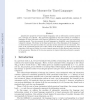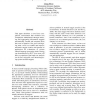1312 search results - page 48 / 263 » Quantitative Comparison of Languages |
FSTTCS
2010
Springer
13 years 8 months ago
2010
Springer
Quantitative properties of timed regular languages, such as information content (growth rate, entropy) are explored. The approach suggested by the same authors is extended to lang...
FMCO
2004
Springer
14 years 3 months ago
2004
Springer
Abstract. Coordination languages are intended to simplify the development of complex software systems by separating the coordination aspects of an application from its computation ...
QEST
2009
IEEE
14 years 4 months ago
2009
IEEE
—Symmetry reduction is a technique for combating state-space explosion in model checking. The generic representatives approach to symmetry reduction uses a language-level transla...
EMNLP
2009
13 years 7 months ago
2009
Distance-based (windowless) word assocation measures have only very recently appeared in the NLP literature and their performance compared to existing windowed or frequency-based ...
NAACL
2007
13 years 11 months ago
2007
This paper describes a novel text comparison environment that facilities text comparison administered through assessing and aggregating information nuggets automatically created a...


